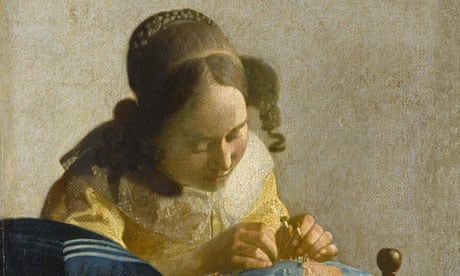Did the 17th-century Dutch artist Johannes Vermeer use a camera obscura – an early photographic instrument in which light is concentrated through a tiny aperture to cast a bright image on a surface in a darkened room – to help him create his mesmerising paintings of life in the tranquil city of Delft?
Undoubtedly. You can see microscopic highlights, lifelike perspectives and shadows in his paintings that strikingly resemble camera images and have no other reason to be there. It's more likely that he used a camera obscura than that he somehow "thought like a camera". Does this precocious photographic technique explain the power of Vermeer's paintings? Not really.
It's true that Vermeer was fully appreciated as an artist only after the invention of modern photography. In the years following his death, he was widely ignored and forgotten, ranked among the lesser Dutch painters of real life – themselves unfairly disdained by 18th-century critics who believed history paintings to be the highest genre of art.
Only in 19th-century France, in the age of the camera, when painters in Paris were once again turning their eyes to the ordinary and unaffected, did critics finally champion the genius of Vermeer. Suddenly he seemed utterly contemporary, his View of Delft a miracle of seeing.
That stardom continues in our own time. The Fitzwilliam Museum in Cambridge has scored an impressive coup by borrowing his great work The Lacemaker from the Louvre for its upcoming exhibition Vermeer's Women: Secrets and Silence. Yet the theme of this exhibition shows how little Vermeer's appeal really has to do with cameras.
What grips us in his art is a silence full of feeling. The voiceless, unfinished dramas he depicts hold the heart and linger in the imagination. A young woman reads a letter at a window. Pale light illuminates her. You can almost feel the hour of the day, sense the slow passing of time in the big house beyond. Who is the letter from, and what does it say?
Novelist Tracy Chevalier was inspired to write a love story about Vermeer, and no wonder: his cool realities are glassy surfaces with torrents of desire raging beneath the apparent calm. This emotional power is built up brushstroke by brushstroke. The way Vermeer portrays reality is not cold, or clinical, or mechanical. Instead, every detail and nuance of colour adds to a sense of obsessive purpose. What awes you is the determination to make his world and its enigmas visible. Vermeer's feeling is what makes him a great painter.
In his View of Delft, a whole city lies under the big sky across the harbour water, built in paint, brick by brick. The compassion is in each point of light. This is Johannes Vermeer's world. You can call this painting photographic if you want, but only when someone invents a camera capable of feeling.

Comments (…)
Sign in or create your Guardian account to join the discussion